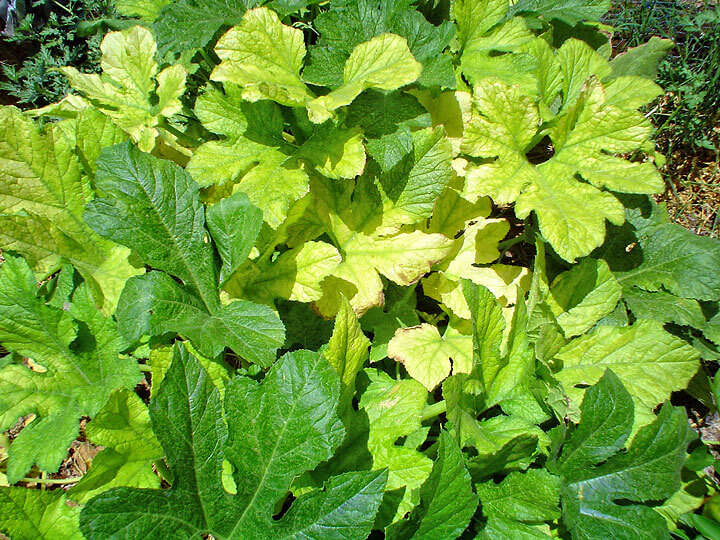
My squash are screaming at me from the back of my garden in the silent language of plants. The big green leaves of my most productive summer squash are turning yellow. This isn’t a water problem because there is no wilt. Closer inspection of the leaves reveals no pests either. Only the veins of the leaves are still green. This condition is called chlorosis, and it can strike virtually any plant that’s experiencing a nutrient deficiency. But don’t let it get you down. Let’s learn more about the condition and how to cure chlorosis with earthworm castings tea.
Plants need two types of nutrients to grow. First are the macro-nutrients we all know from fertilizer packages, which are nitrogen, phosphorous and potassium. These also include to a lesser extent, calcium, magnesium and sulfur. The list of micro-nutrients is much longer, but these are all needed too, often in small quantities and sometimes just a trace. Among the most vital are boron, iron, manganese, zinc, copper, molybdenum and chlorine. The absence of any of these can cause chlorosis.
The actual nutrient deficiency I’m experiencing may be impossible to nail down exactly, and that’s not really necessary to solve the problem. Often folks assume it’s a nitrogen deficiency, but in my case all the other plants around that squash are nice and green, so that isn’t it. Plus, adding nitrogen rich fertilizer to green-up certain summer vegetables is not the best idea. Those that produce their crop via flowers and fruit such as cucumbers, tomatoes and peppers, may stop flowering, which means no more fruit. Sure they’ll grow big and leafy as a result, but that will interfere with future yield.
 The best way to rescue a chlorotic fruiting vegetable plant is to provide a multi-vitamin approach that brings a wide range of macro and micro nutrients into the root zone at the same time. However, for rapid uptake, it must be in a form that’s immediately available to the plant.
The best way to rescue a chlorotic fruiting vegetable plant is to provide a multi-vitamin approach that brings a wide range of macro and micro nutrients into the root zone at the same time. However, for rapid uptake, it must be in a form that’s immediately available to the plant.
Black Gold Earthworm Castings are an all organic fertilizer-like material that is renowned for containing a wide range of macro- and micro-nutrients. That’s why it’s present in many other Black Gold products too. What makes earthworm castings so great is that these nutrients are held in a water soluble form. When applied in a water solution, they enter the root zone and are taken in by that hungry squash immediately.
How To Make Earthworm Castings Tea
If you’re experiencing chlorosis, or a plant that’s simply a poor-doer, create a tea out of earthworm castings and pour it directly onto the root zone of your plant. Though nutrient-rich, there’s no risk of burning the roots. Simply mix one cup or more of earthworm castings into one gallon of water. Be sure to mix again just before you pour it onto your plants to make sure any settled nutrients are again in suspension for even distribution.
Chlorosis in your leafy vegetables such as lettuce or cabbage is treated slightly differently. With these, lots of leafy growth is desirable since this is the part you eat. For these, work in a quality tomato and vegetable fertilizer, then water it in with earthworm castings tea to make sure you’ve covered all he bases. Since all these are OMRI listed, you can confidently apply your nitrogen to leaf crops at any time during the summer or fall season.
Gardening is about recognizing the silent language of plants and interpreting what it means. When leaves turn yellow, be sure to note whether the veins remain green to determine if it’s chlorosis or something else. Then consider if it’s a crop that depends on flowers, or one that’s foliage-based. That tells you exactly how to treat them with confidence using Black Gold all organic fertilizers and potting soils.

